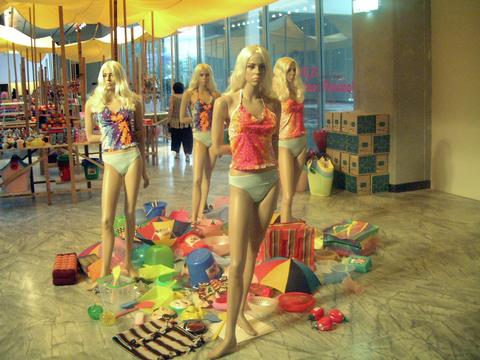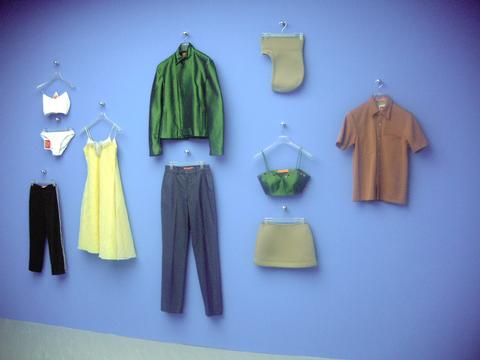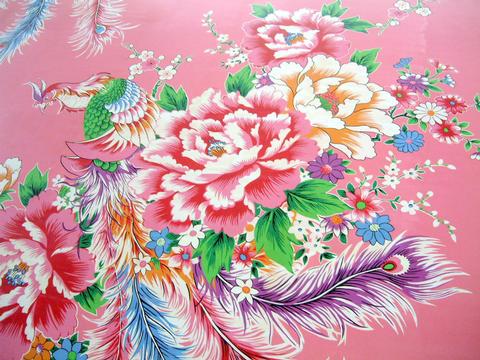The playful and interactive Taipei Biennial 2000 challenges the function of a museum, the traditional idea of art, and is an entertaining and provocative way to spend an afternoon. Here is a short description of each of the art works.
Before entering the Taipei Fine Arts Museum, you will see huge black bands painted on the museum's overhang. Silent Foundation by Sidney Stucki appears like techno codes or abstract art, while his work as both gallery artist and techno DJ blurs the line between art and music.
Inside the museum, the foyer's soft rosy glow is emitted by the traditional Chinese floral and phoenix pattern floor painting by Michael Ming-Hong Lin.

Visitors are invited to walk on the enormous painting and can sit on one of the floral pillows.
Lin's painting transforms the sterile museum space into a domestic and cozy place of hospitality.
Look up and you will see Jun'ya Yamaide's big blue balloons that float like clouds. Yamaide asked local people to write one of the Chinese characters from their names, which he then attached to the balloons and released to the sky.

Surasi Kusolwong's Everything NT$20 contained 1,000 items from Thailand, such as pillows, T-shirts, toys and plastic goods that were offered for sale on the opening night. The sale became a feeding frenzy with people hauling several bags of goods out of the museum within minutes. The items will continue to circulate outside of the museum, bringing art into daily life.
Wang Youshen provides the tools for you to be an artist. He invites direct action by allowing visitors to print photos in his darkroom. While Kendell Geers' Shooting Gallery shows us the entertainment value of extreme violence.
Follow the smell of Chinese cooking and you will enter Pascale Marthine Tayou's walk-in egg-shaped structure that connects his native Cameroon culture with Taiwanese culture through the shared experience of eating.

Take a few moments to contemplate the sacred with Lee Mingwei's shrines that display participants' personal objects. Next are Uri Tzaig and Kim Sooja's video installations. Tzaig alters the rules of the game, while Kim uses the Korean bundle of clothing as her metaphor for life.
You will then be bedazzled by Liza Lou's glittering and beaded Back Yard. A suburban barbecue is transformed into a meticulous shimmery meditation on the passage of time and labor.
Gimhongsok's vibrating LOVE project allows you to ponder the absurdity of love, while Meshac Gaba's interactive puzzles let you think about the Game of Democracy. Wang Du's cluttered installation of toy missiles and newspapers will help you contemplate the strategy of war games.
Artists Claude Closky and Daniel Pflumm show how consumerism affects our lives and how brand names are closely related to art. Closky's video projection of advertising superlatives will jump out at you and Pflumm's corporate logos seem like abstract art.
At the opening, former Geisha girl and musician Hanayo performed her eclectic blend of avant-garde music. On a calmer note, she displays her touching photos of intimate moments with her young daughter.
Combining art, design and psychology, Tobias Rehberger and Wang Junjieh both design total environments for better living. Rehberger's home furnishings are designed according to his friend's suggestions while Wang's Microbiology Association is a fictitious R&D institute to improve life in the future.
Navin Rawanchaikul invites you to sit on a rattan mat, watch his video and eat some watermelon seeds. If you are lucky, your package of seeds may contain a winning ticket for a free mat. Winners are encouraged to document how they use the mat and send photos and letters to Navin.
Stick a banana between your legs or use your head to hold a bucket and a ball against the wall. Hold this position for one minute and you have just become a one-minute sculpture by Erwin Wurm.
Kyupi Kyupi's video projection transports you into a strange world that combines cabaret and burlesque theater, sci-fi pizza delivery girls, and fish-head singers.
Henrik Plenge Jakobsen's Peephole challenges our sense of perception. Peep into the CD player for a new look on reality. Also challenging our sense of perception are Hung Tunglu's large lenticular panels of Japanese cartoon figures juxtaposed on historical Chinese sites.
Jonathan Monk's slide projection In search of Gregory Peck captures the era of the 1950s. Monk reshot photos that his musician father had taken when he was on the road in America.
Mark Lewis' single reel film will mesmerize you by the different senses of time he gives you in four minutes. Michel Majerus focuses on making connections between the architectural space, painting and sculpture and combines visual signs from mass media and fine arts.
Loris Cecchini's large light boxes and soft rubber bicycle and bench will alter your sense of reality.
For the voyeuristic viewer, Shulea Cheang's casting for her upcoming porno flick and Hsia-fei Chang's video of scantily clad babes will satisfy your desires.
Candice Breitz's video loops of duets sung by Whitney Houston and Karen Carpenter to themselves hint at narcissism, while confusing the pronouns "I," "me" and "you" imply psychological disorder and problems with identity.

This month the government ordered a one-year block of Xiaohongshu (小紅書) or Rednote, a Chinese social media platform with more than 3 million users in Taiwan. The government pointed to widespread fraud activity on the platform, along with cybersecurity failures. Officials said that they had reached out to the company and asked it to change. However, they received no response. The pro-China parties, the Chinese Nationalist Party (KMT) and Taiwan People’s Party (TPP), immediately swung into action, denouncing the ban as an attack on free speech. This “free speech” claim was then echoed by the People’s Republic of China (PRC),

Exceptions to the rule are sometimes revealing. For a brief few years, there was an emerging ideological split between the Democratic Progressive Party (DPP) and Chinese Nationalist Party (KMT) that appeared to be pushing the DPP in a direction that would be considered more liberal, and the KMT more conservative. In the previous column, “The KMT-DPP’s bureaucrat-led developmental state” (Dec. 11, page 12), we examined how Taiwan’s democratic system developed, and how both the two main parties largely accepted a similar consensus on how Taiwan should be run domestically and did not split along the left-right lines more familiar in

Specialty sandwiches loaded with the contents of an entire charcuterie board, overflowing with sauces, creams and all manner of creative add-ons, is perhaps one of the biggest global food trends of this year. From London to New York, lines form down the block for mortadella, burrata, pistachio and more stuffed between slices of fresh sourdough, rye or focaccia. To try the trend in Taipei, Munchies Mafia is for sure the spot — could this be the best sandwich in town? Carlos from Spain and Sergio from Mexico opened this spot just seven months ago. The two met working in the

Many people in Taiwan first learned about universal basic income (UBI) — the idea that the government should provide regular, no-strings-attached payments to each citizen — in 2019. While seeking the Democratic nomination for the 2020 US presidential election, Andrew Yang, a politician of Taiwanese descent, said that, if elected, he’d institute a UBI of US$1,000 per month to “get the economic boot off of people’s throats, allowing them to lift their heads up, breathe, and get excited for the future.” His campaign petered out, but the concept of UBI hasn’t gone away. Throughout the industrialized world, there are fears that